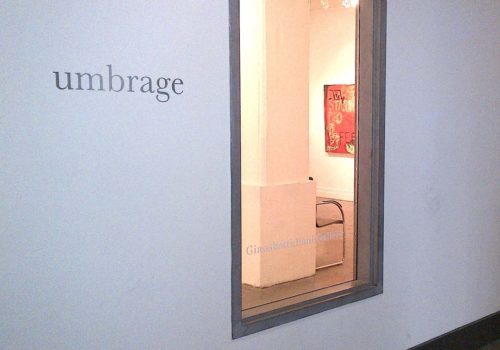Art is the moment we take note, the moment we stop to consider the surface and all that lies beneath. Art empowers us to think for ourselves, to embrace the possibility of layers of meaning and experience cast upon and emanating from the image itself. When set singly, as a print hung upon a wall, the image occupies a physical plane. When sequenced in a long form narrative, as in a book, the image acquires an intellectual frame.
As book publisher and gallerist, Nan Richardson understands this. Richardson, who established Umbrage Books in 1998, has just moved into the Giacobetti Paul Gallery in Dumbo, Brooklyn, having run an independent gallery since 2004. Umbrage will continue to curate a host of exhibitions in its new location, focusing on the space where art, activism, and inspiration meet.
Since moving to Dumbo in 1991, Richardson has witnessed its transformation, both as a resident and as a business owner. In the past two decades, Brooklyn has achieved an eminence on par with Manhattan as a place for powerful and provocative work. Brooklyn has acquired stature throughout the world as companies like Umbrage continue to produce a consistent blend of fine art, photodocumentary, and socially conscious monographs.
Umbrage is committed to telling difficult and challenging stories as a means to transform our world. As Richardson notes, “Art is about many things; to some degree it is an homage to sheer beauty, but it also can be an avenue for social change. The press used to be a vehicle for documentary work, but it no longer is and now more photographers are using the book as a way to present their analysis of what they have witnessed.”
Umbrage authors often work in several media to reach the broadest possible audience, combining the book, the exhibition, and the film as a means to achieve results. One such example is Fambul Tok (“Family Talk”), which used both the book and an accompanying film as a storytelling and teaching opportunity. Fambul Tok emerged in Sierra Leone as a community-owned program to bring together perpetrators and victims of the country’s eleven-year civil war, empowering indigenous peoples to use their own cultural traditions to heal their collective wounds. Fambul Tok has had a profound educational impact on both the community itself and with NGOs working to find effective means of conflict resolution in war-torn countries.
More recently, Umbrage published and exhibited Violentology: A Manual of the Colombian Conflict by Stephen Ferry. A product of ten years of documentation, the story goes beyond the printed page and into real-life drama: one gallery visitor came to see the exhibition and began to cry, recognizing a portrait of the man who killed his grandfather. It was the first time he had seen the man’s face since the murder. It so happens that Mr. Ferry was there at the gallery that day, and the family member relayed his traumatic experience to the artist firsthand.
This level of intimacy, of feeling, understanding, and connection between the artist, subject, and audience has profound power. To name something is to make it so, and for one grandson, the photograph became more than just art; it became evidence, proving that though lives have been taken, they have not been erased.
Richardson has always had the touch, bringing together conversations around the most vulnerable. She collaborates with artists who communicate in a variety of ways, whether in art, photography, or children’s books, like Tribal Alphabet. As she speaks about her children, I am reminded of something else. Our first books are picture books—and so it is to them that we return, as authors, publishers, and readers, seeking meaning in the image and the printed word.
Richardson observes, “Having an eight-year-old son helps me understand how quickly the mind can work and make associations on multiple planes. Images do this in profound ways, traveling at kinetic velocity at all times in the world today. In contrast, the art of making and reading a book forces us to slow down. There is an act of choice in every photograph, in the sequence of those photographs, and in the relationships between the image and the word. The book is a personal story and emerges from a place of personal meditation. In a world of noise and motion it is a rare pleasure to experience the stillness and silence of the book, now more than ever.”
Miss Rosen
















